Swansea, Wales, UK 作者: 来源: 发布时间:2021-09-17
I. Population and Area
Continent: Europe
Country: The U.K
State/Province: Wales
City/Town: Swansea
Total Area: 150.0 (sq mi)
Population in 2016: 179.49 (thousand)
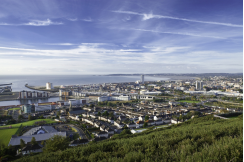
II. Natural Geography (environment and resources)
Geography
Swansea may be divided into four physical areas. The geology is complex, providing diverse scenery. The Gower Peninsula to the west was the first area in the United Kingdom to be designated as an Area of Outstanding Natural Beauty (AONB). Apart from the southeast corner, the whole of the Gower Peninsula is within the AONB. Swansea has numerous urban and country parklands. The region has featured regularly in the Wales in Bloom awards.
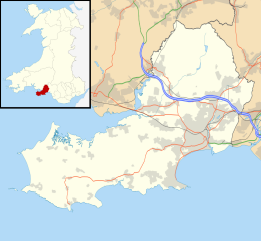
To the north are the Lliw uplands which are mainly open moorland, reaching the foothills of the Black Mountain range. To the east is the coastal strip around Swansea Bay. Cutting through the middle from the southeast to the northwest is the urban and suburban zone stretching from the Swansea city centre to the towns of Gorseinon and Pontarddulais. The most populated areas of Swansea are Morriston, Sketty and the city centre. The chief urbanised area radiates from the city centre towards the north, south and west; along the coast of Swansea Bay to Mumbles; up the Swansea Valley past Landore and Morriston to Clydach; over Townhill and Mayhill to Cwmbwrla, Penlan, Treboeth and Fforestfach; through Uplands, Sketty, Killay to Dunvant; and east of the river from St. Thomas to Bonymaen, Llansamlet and Birchgrove. A second urbanised area is focused on a triangle defined by Gowerton, Gorseinon and Loughor along with the satellite communities of Penllergaer and Pontarddulais. About three-quarters of Swansea is on the coast—the Loughor Estuary, Swansea Bay and the Bristol Channel.
The geology of the Gower Peninsula ranges from Carboniferous Limestone cliffs along its southern edge from Mumbles to Worm's Head and the salt-marshes and dune systems of the Loughor estuary to the north. The eastern, southern and western coasts of the peninsula are lined with numerous sandy beaches both wide and small, separated by steep cliffs. The South Wales Coalfield reaches the coast in the Swansea area. This had a great bearing on the development of the city of Swansea and other nearby towns such as Morriston. The inland area is covered by large swathes of grassland common overlooked by sandstone heath ridges including the prominent Cefn Bryn. The traditional agricultural landscape consists in a patchwork of fields characterised by walls, stone-faced banks and hedgerows. Valleys cut through the peninsula and contain rich deciduous woodland.
Much of Swansea is hilly with the main area of upland being located in the council ward of Mawr. Areas up to 185 metres (607 ft) range across the central section: Kilvey Hill, Townhill and Llwynmawr separate the centre of Swansea from its northern suburbs. Cefn Bryn, a ridge of high land, is the backbone of the Gower Peninsula. Rhossili Down, Hardings Down and Llanmadoc Hill are up to 193 metres (633 ft) high. The highest point is located Penlle'r Castell at 374 metres (1,227 ft) on the northern border with Carmarthenshire.
Road
The M4 motorway, with junctions 44 to 47, bypasses Swansea, replacing the A48 as the main east–west route. Both the M4 and the A48 connect with Neath, Port Talbot and Cardiff to the east and Carmarthen to the west. The A483 dual carriageway links the city centre with the motorway at junction 42 to the east and junction 47 to the north west.
On departing Swansea to the north, the A483 multiplexes with the A48 before continuing through mid Wales and terminating at Chester. The A4067 connecting Mumbles with the city centre and continuing up the Swansea Valley towards Brecon is also a dual carriageway for much of its route through Swansea. Other notable local roads include the A484, which provides a link from Fforestfach west to Llanelli, and the A4118, the main route westwards from the city centre across Gower to Port Eynon.
Rail
Swansea railway station is approximately a ten-minute walk from Swansea bus station. Services calling at Swansea operate to Llanelli, Carmarthen, Haverfordwest, Milford Haven, Tenby, Pembroke Dock and Fishguard Harbour (connecting with the Stena Line to Rosslare Europort and Irish Rail to Dublin Connolly) to the west, Shrewsbury to the northeast via the Heart of Wales Line with four trains each way, Monday–Saturday, and Cardiff Central, Newport, Bristol Parkway, Swindon, Reading and London Paddington to the east run by Great Western Railway. There are also suburban stations in Gowerton, Llansamlet and in Pontarddulais which are served by Transport for Wales.
Air
Swansea Airport is a minor aerodrome situated in the Gower providing recreational flights only. Further development of the airport is strongly resisted by the local communities and environmental groups. Swansea is served by Cardiff Airport, 44 miles (71 km) east, in the Vale of Glamorgan, which provides scheduled domestic and international flights. It is approximately 40 minutes away by road or 70 minutes by rail. Pembrey Airport, 17 miles (27 km) to the west offers charter flights to a few European destinations.
Sea
Swansea Marina to the south of the city centre has berths for 410 leisure boats. An addition 200 berths for leisure boats are located near the mouth of the River Tawe. Further leisure boating berths are being constructed at the Prince of Wales Dock in the Swansea Docks complex. The Swansea Docks complex is owned and operated by Associated British Ports and is used to handle a range of cargo ranging from agribulks and coal to timber and steel. Swansea Docks consists of three floating docks and a ferry terminal.
Fastnet Line operated a Swansea Cork Ferry roll-on/roll-off service until November 2011, when the service was ended. A proposal for a catamaran-based passenger ferry service from Ilfracombe to Swansea—scheduled to begin in time for Easter in 2010— has yet to launch. It would have had two return trips a day taking around 50 minutes each way and carried cycles.
III. Economy
Many parts of Wales suffered from a continuous decline in heavy industry over the 20th century, culminating in the virtual disappearance of coal-mining in the 1980s. The demise of 'smokestack' industries left a legacy of high unemployment, and although unemployment has declined in recent years, unemployment in West Wales and the Valleys still tends to be higher than the Welsh average and economic inactivity (a form of hidden unemployment) continues to be a major problem in these areas. Merthyr Tydfil and Neath Port Talbot have some of the largest proportions of people in the UK not working due to long-term illness or disability, though some believe that in reality many people classified as "unable to work" through sickness are low-skilled workers encouraged to exit the labour market by the benefits system as well as declining demand for their skills.
The figures below for 2013 come from Eurostat and are denoted in Euros.
Regions (NUTS3) | GDP € (2013) | GDP per capita € (2013) | GDP € (2016) | GDP per capita € (2016) |
Isle of Anglesey | € 1.167 bn | €16,700 | € 1.305 bn | €18,600 |
Gwynedd | € 2.956 bn | €24,200 | € 3.224 bn | €26,000 |
Conwy & Denbighshire | € 4.246 bn | €20,200 | € 4.767 bn | €22,600 |
South West Wales | € 7.678 bn | €20,000 | € 8.723 bn | €22,700 |
Central Valleys | € 5.939 bn | €20,100 | € 6.812 bn | €22,900 |
Gwent Valleys | € 5.962 bn | €17,500 | € 6.923 bn | €20,200 |
Bridgend & Neath Port Talbot | € 6.016 bn | €21,500 | € 7.240 bn | €25,400 |
Swansea | € 5.532 bn | €23,100 | € 6.332 bn | €25,800 |
Monmouthshire & Newport | € 6.322 bn | €26,500 | € 7.260 bn | €30,000 |
Cardiff & Vale of Glamorgan | € 14.361 bn | €30,000 | € 16.590 bn | €33,900 |
Flintshire & Wrexham | € 8.346 bn | €28,800 | € 9.374 bn | €32,200 |
Powys | € 2.869 bn | €21,600 | € 3.134 bn | €23,700 |
TOTAL | € 71.396 bn | €23,200 | €81.683 bn | €26,200 |
IV. Industrial Characterisitics
Major industries:
During the 19th-century industrial heyday, Swansea was the key centre of the copper-smelting industry, earning the nickname Copperopolis.
Through the 20th century, heavy industries in the town declined, leaving the Lower Swansea Valley filled with derelict works and mounds of waste products from them. The Lower Swansea Valley Scheme (which still continues) reclaimed much of the land. The present Enterprise Zone was the result and, of the many original docks, only those outside the city continue to work as docks; North Dock is now Parc Tawe and South Dock became the Marina.
Swansea originally developed as centre for metals and mining, especially the copper industry, from the beginning of the 18th century. The industry reached its apogee in the 1880s, when 60% of the copper ores imported to Britain were smelted in the Lower Swansea valley. However, by the end of the Second World War these heavy industries were in decline, and over the post-war decades Swansea shared in the general trend towards a post-industrial, service sector economy.
Major projects and related introductions:
Liberty Stadium and Swansea Building Control
The stadium has been built on the site of the former Morfa Stadium, home to Swansea Harriers Athletics Club. Morfa Stadium staged Welsh and British athletics championships as well as many pop concerts and other entertainment.
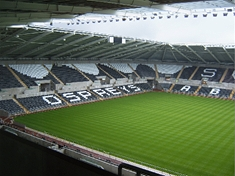
The completed Liberty Stadium has a capacity of 20,000 and is the shared home of Swansea City Football Club and the Ospreys regional rugby team. It will also continue to host large scale music and entertainment events. The design of the stadium was very important as it has not only had to cater for two different kind of sports, but needs to be suitable for many other uses.
Work began on the building at the start of 2004 and was successfully completed in time for the start of the 2005-06 football and rugby seasons. The opening game took place in the stadium between Swansea City and Fulham on 23rd July 2005. On May 13th 2012 Swansea City beat Liverpool 1-0 to complete their first season in the English Premier League.
Reference Website:
https://en.wikipedia.org/wiki/Swansea#Economy
V. Attractions
1. The Gower Peninsula:
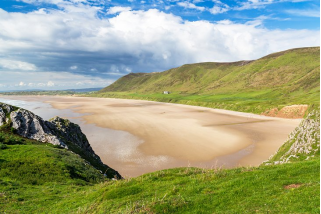
The Mumbles form the gateway to the Gower Peninsula, a limestone massif of great scenic beauty. In fact, it's so attractive that the charming Welsh south coast here has been classified as an Area of Outstanding Natural Beauty and is a nature reserve that, apart from the towns and villages, is only accessible on foot.
There are a number of beaches to explore here, including sandy stretches at Langland and Caswell Bay, which are particularly popular among surfers. The Gower Peninsula is the place to be for tourists who like adventure. Whether you like to walk, waterski, abseil, sail, wakeboard, or play golf, you're sure to find something fun to keep you occupied.
2. Three Cliffs Bay:
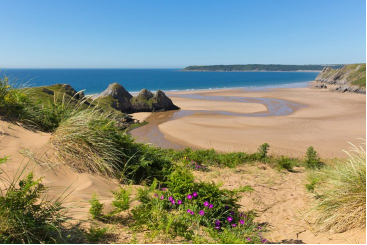
This breathtakingly beautiful bay is situated on the south coast of the Gower Peninsula. So named for the three cliffs that jut into the bay, it's a perfect place for a walk or picnic.
Although getting down to the beach can be a bit steep and cumbersome, the view is worth every step. Many tourists enjoy the spot so much, they park caravans nearby to enjoy a camping holiday. Others bring their dogs along to frolic in the water.
3. Dylan Thomas Birth Place:
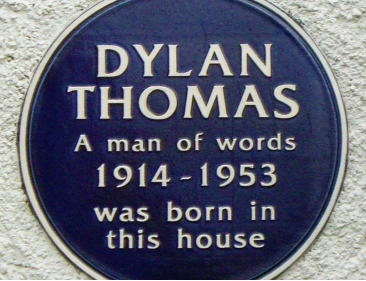
This restored home of famed Welsh poet and writer Dylan Thomas allows tourists to step back in time. Guests can enjoy an Edwardian afternoon tea party, lunch, or dinner in Thomas's old abode. They can eat in Thomas's parlor and snoop through his study while soaking up stories of the poet's life on a guided tour.
If walking through the house isn't enough, guests may choose to spend the night. Tourists are more than welcome to snuggle up in one of the house's cozy, perfectly restored bedrooms, which remain much as they would have in 1914.
Another plus: the owners of the house offer guided tours of Thomas's old haunts. A well-trained guide takes tourists through Swansea, the Uplands, Mumbles and Gower and makes them feel as if they're seeing these places through Thomas's eyes. Those who really want to impress their friends can hire actors to perform Thomas's works at the house. Call before visiting as the house may be booked for an event.
Reference Website:
https://www.planetware.com/tourist-attractions-/swansea-abertawe-w-wg-sw.htm
VI. History
Ancient history
The area around Swansea has a unique archaeological history dating back to the Palaeolithic. Finds at Long Hole Cave on the Gower Peninsula have been interpreted as that of the first modern humans in Britain, and the same area is also home to the oldest ceremonial burial in Western Europe, discovered at Paviland in 1823, and dated to 22,000 BC The area also has many Bronze Age and Iron Age sites, such as the burial mound at Cillibion and the hill fort at Cil Ifor. There is also the remains of a Roman villa again on the Gower peninsula.
Medieval Swansea
The area that would become Swansea is located on the eastern edge of the cwmwd of Gwyr, in the Cantref Eginawc, the easternmost Cantref of Ystrad Tywi. The area was noted for its valuable land and was highly contested by the early Welsh kingdoms. During the Viking Age, the mouth of the Tawe became a focus for trade, and a trade post may have been founded sometime between the 9th and 11th centuries. When the Normans took control of the settlement, they built Swansea Castle c. 1106 and minted coins bearing the names Swensi, Sweni and Svenshi c. 1140.
The first charter was granted sometime between 1158 and 1184 by William de Newburgh, 3rd Earl of Warwick. This charter contains the earliest reference in English to Sweynesse and gave it the status of a borough, granting the townsmen (called burgesses) certain rights to develop the area. In 1215 King John granted a second charter, in which the name appears as Sweyneshe. A town seal which is believed to date from this period names the town as Sweyse.
Following the Norman conquest, a marcher lordship was granted by Henry I under the title of Gower. It included land around Swansea Bay as far as the River Tawe, the manor of Kilvey beyond the Tawe, and the peninsula itself. Swansea was designated chief town of the lordship and received a borough charter at some point between 1158 and 1184 (and a more elaborate one in 1304).
20th century
Through the 20th century, heavy industries in the town declined, leaving the Lower Swansea Valley filled with derelict works and mounds of waste products from them. The Lower Swansea Valley Scheme (which still continues) reclaimed much of the land. The present Enterprise Zone was the result and, of the many original docks, only those outside the city continue to work as docks; North Dock is now Parc Tawe and South Dock became the Marina.
In the Second World War, Swansea's industrial importance made it a target of German bombing, and much of the town centre was destroyed during the Swansea Blitz on the 19, 20 and 21 February 1941 (the 'Three Nights Blitz'). In 1969 Swansea was granted city status to mark Prince Charles's investiture as the Prince of Wales. The Prince made the announcement on 3 July 1969 during a tour of Wales. Swansea obtained the further right to have a Lord Mayor in 1982.
Within the city centre are the ruins of the castle, the Marina, the Glynn Vivian Art Gallery, Swansea Museum, the Dylan Thomas Centre, the Environment Centre, and the Market, which is the largest covered market in Wales. It backs onto the Quadrant Shopping Centre, which opened in 1978, and the adjoining St David's Centre opened in 1982. Other notable modern buildings include the BT Tower (formerly the GPO tower) built around 1970, Alexandra House opened in 1976, County Hall opened in July 1982. Swansea Leisure Centre opened in 1977; it has undergone extensive refurbishment which retained elements of the original structure and re-opened in March 2008.
VII. Culture
Performing arts
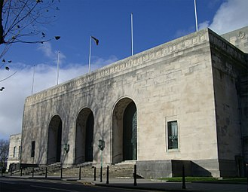
The Grand Theatre in the centre of the city is a Victorian theatre which celebrated its centenary in 1997 and which has a capacity of a little over a thousand people. It was opened by the celebrated opera singer Adelina Patti and was refurbished from 1983 to 1987. The annual programme ranges from pantomime and drama to opera and ballet. Fluellen Theatre Company is a professional theatre company based in Swansea who perform at the Grand Theatre and the Dylan Thomas Centre. The Taliesin building on the university campus has a theatre, opened in 1984. Other theatres include the Dylan Thomas Theatre (formerly the Little Theatre) near the marina, and one in Penyrheol Leisure Centre near Gorseinon. In the summer, outdoor Shakespeare performances are a regular feature at Oystermouth Castle, and Singleton Park is the venue for a number of parties and concerts, from dance music to outdoor Proms. A folk festival is held on Gower. Standing near Victoria Park on the coast road is the Patti Pavilion; this was the Winter Garden from Adelina Patti's Craig-y-Nos estate in the upper Swansea valley, which she donated to the town in 1918. It is used as a venue for music shows and fairs. The Brangwyn Hall is a multi-use venue with events such as the graduation ceremonies for Swansea University. Every autumn, Swansea hosts a Festival of Music and the Arts, when international orchestras and soloists visit the Brangwyn Hall. The Brangwyn Hall is praised for its acoustics for recitals, orchestral pieces and chamber music alike.
Festivals
Swansea hosted the National Eisteddfod in 1863, 1891, 1907, 1926, 1964, 1982 and 2006. The 2006 event occupied the site of the former Felindre tinplate works to the north of the city and featured a strikingly pink main tent. In 2009 Swansea Council launched Wales's only week long St David's Week festival in venues throughout the city. The Beginning and Do Not Go Gentle are Festivals in the Uplands area of the city where Dylan Thomas was born and lived for 23 years.
Welsh language
There are many Welsh language chapels and churches in the area. Welsh-medium education is a popular and growing choice for both English- and Welsh-speaking families. Just over 1,600 secondary pupils were educated through the medium of Welsh in 2017. Nearly double this figure, 3,063 pupils are currently educated through the medium of Welsh in the primary sector. The 2014 Swansea Pre-School survey showed that 35% of parents across the City and County of Swansea would select a Welsh education for their children if there was a local Welsh school available to them. 45% of the rural council ward Mawr are able to speak Welsh, as can 38% of the ward of Pontarddulais. Clydach, Kingsbridge and Upper Loughor all have levels of more than 20%. By contrast, the urban St. Thomas has one of the lowest figures in Wales, at 6.4%, a figure only barely lower than Penderry and Townhill wards.
VIII. Other information
A number of beaches around Swansea Bay are promoted to visitors. Surfing is possible at Langland Bay, Caswell Bay and Llangennith, with the latter winning accolades from two national newspapers for the quality of its waves. The five-mile promenade from the Marina to Mumbles offers views across Swansea Bay. The seaside village of Mumbles has a Victorian pier, small, independent shops and boutiques, restaurants and cafes. The south coast of Gower is the chief magnet for walkers, with a path stretching from Mumbles Head across the cliff tops, beaches and coastal woodland to Rhossili.
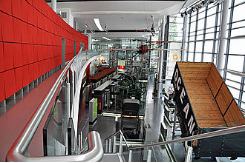
On the Waterfront, Swansea Bay has a five-mile (8 km) sweep of coastline which features a beach, promenade, children's lido, leisure pool, marina and maritime quarter featuring the museums the National Waterfront Museum and Swansea Museum, the oldest museum in Wales. Also situated in the maritime quarter is the Dylan Thomas Centre, which celebrates the life and work of the author with its permanent exhibition 'Dylan Thomas – Man and Myth', and Mission Gallery, a unique art gallery also in the heart of the Maritime Quarter which hosts a range of exhibitions from various art disciplines; it also host a craft space, with ranging works from local and international artists. The Dylan Thomas Centre is the focal point for the annual Dylan Thomas Festival (27 October – 9 November). There is a permanent exhibition at the Dylan Thomas Birthplace and Home for 23 years in Uplands which has been restored to its condition as a new house when bought by the Thomas family in 1914 a few months before Dylan was born in the front bedroom. The SA1 Waterfront area is the latest development for living, dining and leisure.
Swansea Bay, Mumbles and Gower are home to various parks and gardens and almost 20 nature reserves. Clyne Gardens is home to a collection of plants set in parkland and host to 'Clyne in Bloom' in May. Singleton Park has acres of parkland, a botanical garden, a boating lake with pedal boats, and crazy golf. Plantasia is a tropical hothouse pyramid featuring three climatic zones, housing a variety of unusual plants, including several species which are extinct in the wild, and monkeys, reptiles, fish and a butterfly house. Other parks include Cwmdonkin Park, where Dylan Thomas played as a child, and Victoria Park which is close to the promenade on the seafront.
Oxwich Bay on the Gower Peninsula was named the most beautiful beach in Britain by travel writers who visited more than 1,000 beaches around the world in search of the perfect sands (2007). The Travel Magazine praised Oxwich for "magnificent and unspoilt" scenery and as a "great place for adults and children to explore". It has over three miles (5 km) of sand and The Guardian named it one of Britain's blue-riband top 10 category beaches (2007). The Independent newspaper hailed Rhossili Bay as "the British supermodel of beaches" (2006) and the best beach in Britain for breathtaking cliffs (2007), whilst The Sunday Times listed it as one of the 25 best beaches in the world (2006). Thanks to its clear air and lovely golden sand, this romantic stretch of sand was voted the best place in the UK to watch the sun set (Country Living magazine 2005) and one of the top romantic spots in the country (The Guardian 2007).
IX. Contact information
Mayor/Officer: Mark Child
Tel: 01792 635600
Mail: evh@swansea.gov.uk
Reference Website:
https://www.swansea.gov.uk/swanseaslordmayor
